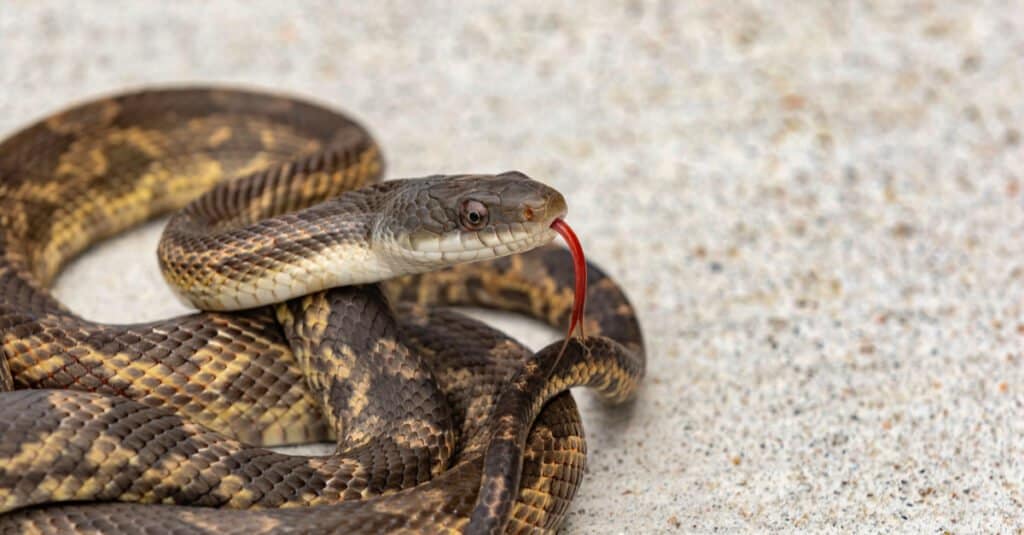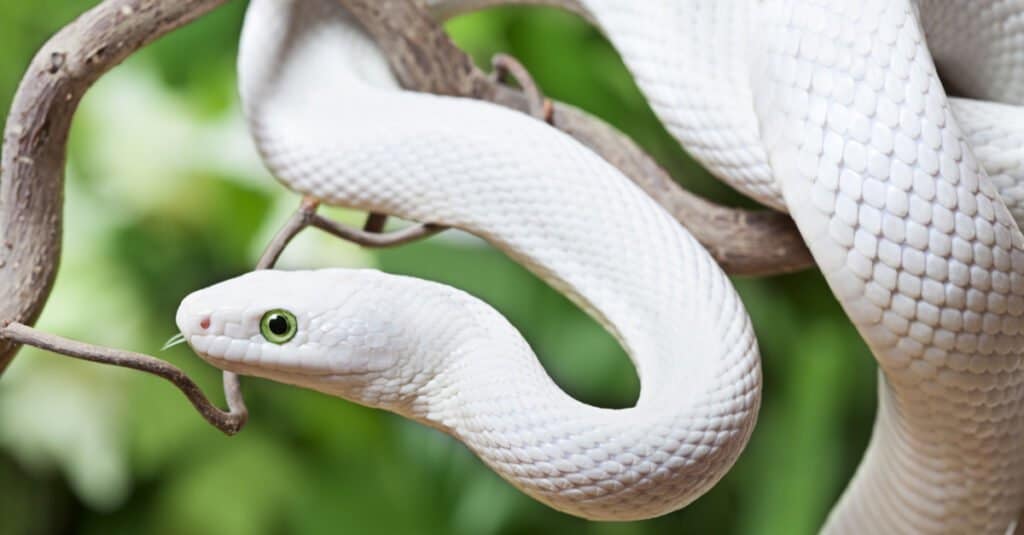Texas Rat Snake
.jumbotron {
background-image: url(“https://a-z-animals.com/media/2022/01/Texas-Rat-Snake-header-400×300.jpg”);
}
}
@media only screen and (min-width: 641px) and (max-width: 920px) {
.jumbotron {
background-image: url(“https://a-z-animals.com/media/2022/01/Texas-Rat-Snake-header-470×370.jpg”);
}
}
@media only screen and (min-width: 921px) {
.jumbotron {
background-image: url(“https://a-z-animals.com/media/2022/01/Texas-Rat-Snake-header.jpg”);
}
}
Texas Rat Snake
Pantherophis obsoletus lindheimeri
The Texas rat snake is one of the most common subspecies of the western rat snake in the wild.
Texas Rat Snake Scientific Classification
- Kingdom
- Animalia
- Phylum
- Chordata
- Class
- Reptilia
- Order
- Squamata
- Family
- Colubridae
- Genus
- Pantherophis
- Scientific Name
- Pantherophis obsoletus lindheimeri
Read our Complete Guide to Classification of Animals.
Texas Rat Snake Conservation Status
Texas Rat Snake Facts
- Prey
- Rodents, reptiles, frogs, birds, eggs, and insects
- Group Behavior
-
- Solitary
- Fun Fact
- The Texas rat snake is one of the most common subspecies of the western rat snake in the wild.
- Litter Size
- 12-20 eggs
- Habitat
- forests, grasslands, swamps, and suburban and urban areas.
- Diet
- Carnivore
- Lifestyle
-
- Nocturnal
- Common Name
- Texas rat snake
- Location
- south-central region of the United States
This post may contain affiliate links to our partners like Chewy, Amazon, and others. Purchasing through these helps us further the A-Z Animals mission to educate about the world’s species..

Discover alligator-eating snakes, spiders larger than your phone, and 1000 more incredible animals in our daily FREE email.
.photo-gallery {
–margin: 0px auto 0px;
–padding: 0px 0px 0px 0px;
}
.gallery-link {
background-image: url(“https://a-z-animals.com/media/2022/01/Texas-Rat-Snake-header-1024×535.jpg”);
background-repeat: no-repeat;
background-size: cover;
background-position: center;
height: 500px;
justify-content: center;
text-align: center;
align-items: center;
display: flex;
border: 2px solid #000;
}
.gallery-link img {
height: 50%;
}
@media only screen and (max-width: 768px) {
.gallery-link {
height: 300px !important;
}
}
View all of the Texas Rat Snake images!
The Texas rat snake is one of the most common subspecies of the western rat snake in the wild.
If you live anywhere in the south-central United States, then you may see these large snakes out in the grass or somewhere near you’re home, but don’t panic. They’re generally not dangerous to people and can be safely avoided. They even make for good pets provided you’re willing to properly care for one. This article will cover some fascinating facts about the identification, habitat, lifespan, behavior, and predators of the Texas rat snake.
5 Texas Rat Snake Amazing Facts
- Rat snakes are semi-arboreal. They are good climbers and spend at least part of their time in trees. They are also considered to be excellent swimmers.
- Rat snakes tend to be nocturnal (meaning they primarily hunt at night) the farther south you go. However, they still need to soak up the sun in the daytime to warm their bodies. In colder climates, they hibernate for the winter.
- Males will attract mates with the use of pheromones. They will sometimes fight each other for access to the females.
- Once impregnated, females lay a clutch of 12 to 20 eggs in hollow logs, compost piles, and other hidden locations. The young hatch about two months later, measuring about a foot long. Since they receive no parental care, many of the juveniles fall prey to fearsome predators such as hawks and other snakes. Burying beetles will sometimes lay larvae on the snake eggs, which then consume the growing embryo inside.
- Rat snakes are sometimes known to consume chicken eggs, which has given it the alternate name of chicken snake.
Where to Find Texas Rat Snakes
The Texas rat snake can be found throughout the entire south-central region of the United States, including Texas, Oklahoma, Arkansas, and Louisiana. They are comfortable with living in a variety of different habitats and locations, including forests, grasslands, swamps, and suburban and urban areas.
button.pulse {
transform: scale(1); animation: pulse 2s infinite;
box-shadow: 0 0 0 0 rgba(11, 247, 25, 1);
}
@keyframes pulse {
0% { transform: scale(0.90); box-shadow: 0 0 0 0 rgba(11, 247, 25, 0.5); }
60% { transform: scale(1); box-shadow: 0 0 0 15px rgba(11, 247, 25, 0); }
100% { transform: scale(0.90); box-shadow: 0 0 0 0 rgba(11, 247, 25, 0); }
}
Texas Rat Snake Scientific Name
The scientific name is Pantherophis obsoletus lindheimeri. This subspecies of the western rat snake was named in honor of the person who first classified it, the German American naturalist Ferdinand Jacob Lindheimer. It was originally a part of the genus Elaphe, but based on DNA evidence, some experts recommended moving the species into the genus Pantherophis instead (a name which essentially means panther snake). However, since this is not universally recognized, some organizations still classify it in the genus Elaphe.
Texas Rat Snake Population & Conservation Status
As a subspecies, the Texas rat snake has not been given its own separate conservation status, but according to the IUCN Red List, the entire western rat snake group is considered to be a species of least concern. We do not have enough facts about their population numbers to make a good estimate, but they appear to be quite common and widespread throughout their entire natural range.
How to Identify Texas Rat Snakes: Appearance and Description
The Texas rat snake is a relatively long snake, measuring about 4 to 6 feet in size. The skin can come in multiple colors, including green, reddish-brown, or yellow with gray bellies and heads and irregular blotches along the entire length of the body. White albino snakes are sometimes born as well; they’re particularly popular in the pet trade but quite rare in the wild. Males and females tend to look similar to each other.
How to identify the snake:
- Long, slender body
- Large triangle-shaped head
- Reddish brown, yellow, or olive-green body with gray head and light belly
- Darker blotches from head to tail
- White albinos with no blotches are common in the pet trade
Texas Rat Snake Pictures

South O Boy/Shutterstock.com

Silent Shoot/Shutterstock.com

Kuznetsov Alexey/Shutterstock.com
Texas Rat Snake: How Dangerous Are They?
Despite their large size, these snakes do not pose any significant danger to people. These are non-venomous snakes without any sharp fangs. While it’s generally recommended to leave them alone, you also don’t have anything to really fear from them.
Texas Rat Snake Behavior and Humans
These snakes can be a little defensive around people. When they’re disturbed, some may open their mouths and try to bite, but most of them would prefer to run away and hide. They have the ability to vibrate their tails to mimic the far more dangerous rattlesnake in hopes that any potential predators will be fooled. The lack of a rattle on the tail will help greatly in identification, however. If this mimicry fails, then the rat snake can also release a foul-smelling substance around it to deter predators.
View all 74 animals that start with T
Texas Rat Snake FAQs (Frequently Asked Questions)
Are Texas rat snakes venomous?
No, these reptiles are not venomous snakes.
How do Texas rat snakes hunt?
Rat snakes are ambush predators. They will remain in the same spot for hours and wait for the prey to wander by. Once the snake has apprehended its prey, it will squeeze the life out of the animal by coiling the body around it. There are some misconceptions that the squeezing action will crush the bones of its prey. Instead, it’s thought that the constriction may prevent blood from flowing to the brain, which kills the prey within just a few seconds. Once the prey is dead, the snake will swallow it whole. Dangerous venom and sharp fangs are not required at all to subdue the prey.
Are Texas Rat Snakes aggressive?
When they’re disturbed, the rat snake’s behavior can vary a bit. Some will strike out at people and bite, but most will just try to flee. Fortunately, the bites are not very dangerous at all.
Where do Texas rat snakes live?
Grasslands, forests, and urban locations throughout the south-central United States are its main habitats.
What do Texas rat snakes eat?
The diet consists of all kinds of different prey, including lizards, frogs, rodents, birds, eggs, and soft-bodied insects.
What does a Texas rat snake look like?
Identification can be a little tricky because its colors can vary based on its location. The Texas rat snake can attain a size between 4 and 6 feet. Its body usually comes in yellow, brown, or olive-green colors with a gray-colored head and irregular blotches along its entire length. White albinos are rare in the wild.
How do I catch a Texas rat snake?
You can usually catch a snake with a simple hook on a pole and a bucket or bag to put it in. This is particularly helpful if you want to remove the snake from your home or yard. If you are trying to capture one as a pet, then it’s recommended that you buy one from a pet store instead.
How do I care for a Texas rat snake?
The Texas rat snake will need an enclosure of different sizes throughout its lifetime. A juvenile should do well with a 20-gallon enclosure, while an adult will need at least 55 gallons. Wood shavings such as aspen and cypress should provide a suitable substrate for your snake. However, you should avoid oily woods such as cedar and pine that can affect their health. The snake will need at least 12 hours of light a day from a suitable heat lamp placed in the enclosure. Specialized UV lamps are not necessary to keep them healthy. Texas rat snakes need to be fed every five to seven days, although adults can sometimes go a little longer than that. Although their diet is quite diverse in the wild, they can be fed only rodents in captivity (rats as an adult, mice as a juvenile). The snake should not be handled after they shed or eat. If it’s well cared for, this reptile often has a lifespan of at least 10 years.
How big can Texas rat snakes get?
They can reach up to 6 feet long in most circumstances.
What’s the difference between a Texas rat snake and a copperhead?
The main differences between Texas rat snakes and copperheads are that they belong to different families, inhabit slightly different ranges, and have unique physical characteristics. They differ in size, reproduce by different methods, kill prey with different strategies, and only one of them poses a threat to humans.
Sources
- Live Science, Available here: https://www.livescience.com/53855-rat-snake.html
- Reptiles, Available here: https://reptilesmagazine.com/texas-rat-snake-care-sheet/
















